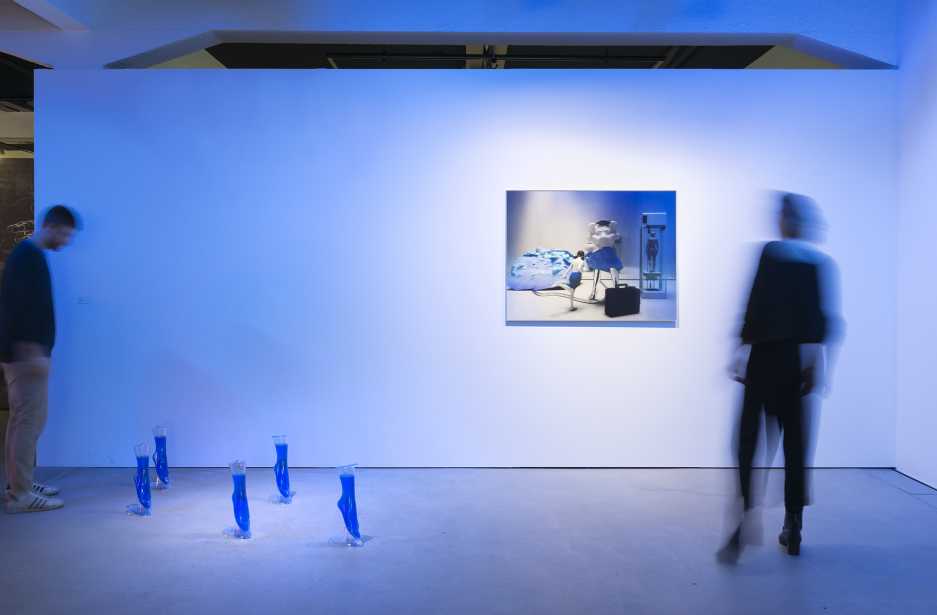Digicult has written a review of Future Love: Desire and Kinship in Hypernature, a group show at Haus der electronischen Künste Basel featuring works by !Mediengruppe Bitnik.
“Future Love”: Desire and Kinship in Hypernature
The group exhibition Future Love examines the impact of new technologies and social media on our affective relationships and sexuality. Never has the future of our emotional, sexual and familial relationships appeared more exciting, promising and troubled as today. Biotechnologies are presenting alternative means of reproduction, altering gender roles and their biological boundaries, while also challenging the traditional structures of family ties.
New industrial products offer to fulfill unconventional sexual fantasies, which can be realised through both physical and virtual realties. Global connectivity allows for the circulation of alternative models of love and sexuality, which continue to provoke ideological debates among puritans and liberals, but are increasingly accepted by the wider population.
This new interdependence of technology, engineering and environment constitutes a new concept: hypernature, an enhanced version of the ecosystem including artificial bodies and their correlations. In this context, some of the most farsighted theorists question our predominating role in the ecosphere, inciting us to go beyond the common discourses about the Anthropocene, while discussing our imperative instincts for reproduction and survival.
This debate prompts us to rethink our identities and our behaviours. Have the recent developments of new technologies and social media fundamentally changed our relationships and sexualities? What influence do they have on our ideas of love, family, and gender roles?
Moving from a postdigital background, the international artists participating in this exhibition tackle these questions through a variety of media, from biotechnologies to virtual reality. They give shape to diverse, personal visions regarding our current sexual and romantic inclinations, including aspects not only related to personal romance, but also to sexuality as a sign of affection, a reproductive process or a recreational act.
Tabita Rezaire, for instance, creates videos installations in which she merges elements of traditional African culture with cyberfuturism to generate healing mantras subverting the western, patriarchal positions on sexuality, while Wong Ping’s flashing animations touch upon sexual repressions and frustrations.
Una Szeemann produces 3D printed sculptures that are the result of her meditations, under hypnosis, of modern-day romance in the age of dating-apps, while !Mediengruppe Bitnik display the cynical mechanics underlying precisely these online services. Artist and activist Micha Cardenas has developed apps that are specifically conceived for transgender users, to fill a gap in a market heavily determined by heteronormative models.
Correspondingly, Mary Maggic creates fictional documentaries describing DIY protocols for hacking oestrogen, to discuss trans and women’s access to such hormones. Some artists, such as Pinar Yoldas and Špela Petrič, speculate about biotechnologies and the possibility of giving birth to designer children or even new species, while the works of Dmitry Morozov (alias ::vtol::) and Karen Lancel & Hermen Maat explore how bio-feedback and wearable devices offer a means to record, analyse and possibly enhance our sexual behaviours.
Works of virtual reality such as the ones by Ed Fornieles allow for the experience of unsettling encounters with unexpected partners. Lastly, the compound installations by Joey Holder, Chloé Delarue and Olga Fedorova give shape to visionary and emblematic representations of our modern-day troubled sexuality.
Future Love offers critical, unconventional and imaginative views on our impending life while commenting on the present evolution of society and the imminent changes, challenges and opportunities that might affect our behaviours. The works on display are speculative, critical and at times utopic, inviting us to contemplate our models of affective relationships that define our condition as human beings and our presence in the ecosphere.


